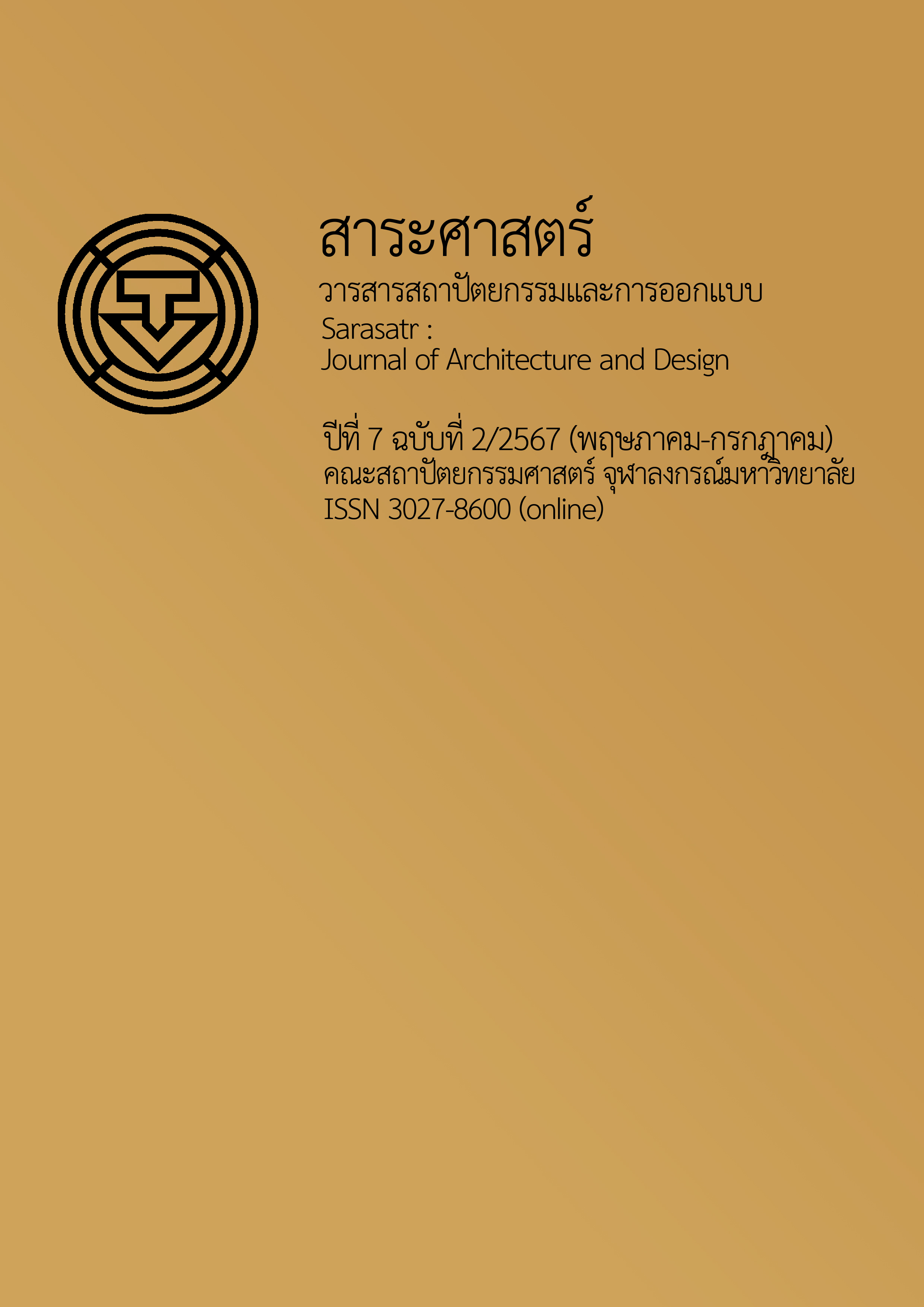The Study of Environment Suitable for Dependent Elderly People in Private Sector Establishments: A Case Study of Bangkok Metropolitan Region and its Vicinity
Main Article Content
Abstract
From the situation where the number of elderly population is continuously increasing. The United Nations has predicted that the period 2001 - 2100 will be the Century of the Elderly. Obviously, developed countries have the highest number of elderly people in the world and most of them have entered the elderly society. While Asia has the 4th largest elderly population in the world, the situation in ASEAN countries consists of 10 member countries. Thailand has the 2nd highest elderly population among the ASEAN member countries with the highest number of elderly people in 2023. Thailand's population structure is in Towards a completely aging society Such changes Housing and elderly care business To support and reach the elderly who are dependent. From a study of the types of accommodations for the elderly, palliative care or dependent people who need 24-hour care, the provision of accommodations, nursing care, and having full-time caregivers has a tendency to expand, with the highest number of applications for permission accounting. It is 97 percent of all permission requests. from the increasing expansion of the elderly Increased establishments Modifying the physical environment accordingly to prepare a place to accommodate or modify the environment in the original area to be suitable for the dependency of the elderly in order to restore and promote a better quality of life This issue therefore becomes an important source of this study. The objective is to study the physical characteristics of establishments that currently provide care for the elderly, and to suggest guidelines for developing and improving these establishments that care for dependent elderly people and suit to the context of Thai aging society. From interviews with specialists in order to draw conclusions and recommendations. By collecting data through questionnaires, interviews, and non-participant observation. and surveying the area. This research project included 3 case studies.
The results of the study found that the physical characteristics of establishments that care for the elderly are problematic. There are limitations and obstacles that are not suitable for use. Each project will have different usage limitations in each order. And the problems found are the same but in a different order, such as bathrooms, internal thoroughfares, materials, common areas, storage rooms. Most of them are mainly caused by modifications from the original building that were not designed according to the principles of Universal Design.
Article Details
References
กฎกระทรวง กำหนดมาตรฐานด้านความสถานที่ ความปลอดภัย และการให้บริการในสถานประกอบการเพื่อสุขภาพประเภทกิจการดูแลผู้สูงอายุหรือผู้มีภาวะพึ่งพิงพ.ศ. 2563. (2563, 31 กรกฎาคม). ราชกิจจานุเบกษา. เล่ม 137 ตอนที่ 61ก หน้า 10-15.
กรมกิจการผู้สูงอายุ. (ม.ป.ป.). คู่มือระบบดูแลและคุ้มครองพิทักษ์สิทธิผู้สูงอายุในระดับพื้นที่. กระทรวงการพัฒนาสังคมและความมั่นคงของมนุษย์. https://www.dop.go.th/download/knowledge/th1561080125
กองส่งเสริมศักยภาพผู้สูงอายุ. กลุ่มเสริมสร้างและพัฒนาศักยภาพเครือข่าย. (2564, มีนาคม). จับตา “เศรษฐกิจสูงวัย” อำนาจเปลี่ยนขั้วจากมิลเลนเนียมสู่ผู้สูงอายุ ภายในปี 2050. กรมกิจการผู้สูงอายุ. https://www.dop.go.th/th/know/15/796
กิตติอร ศิริสุข. (2565). มาตรฐานขั้นต่ำของพื้นที่ห้องพักและพื้นที่ส่วนกลางของสถานดูแลผู้สูงอายุระยะยาว. คณะสถาปัตยกรรมศาสตร์ จุฬาลงกรณ์มหาวิทยาลัย.
โกศล จึงเสถียรทรัพย์. (2559). สถาปัตยกรรมโรงพยาบาลและสิ่งแวดล้อมเพื่อการเยียวยา: Vol. 33. สำนักพิมพ์สุขศาลา-สำนักวิจัยสังคมและสุขภาพ(สวสส.).
ไตรรัตน์ จารุทัศน์ (2561). การออกแบบเพื่อทุกคน (UNIVERSAL DESIGN): Vol. 1. โรงพิมพ์แห่งจุฬาลงกรณ์มหาวิทยาลัย.
ไตรรัตน์ จารุทัศน์, กิตติอร ศิริสุข, จิราพร เกศพิชญวัฒนา, และศรัณยา หล่อมณีนพรัตน์. (2548). มาตรฐานขั้นต่ำสำหรับที่พักอาศัยและสภาพแวดล้อมของผู้สูงอายุ. สำนักงานกองทุนสนับสนุนการวิจัย (สกว.).
ธนาคารอาคารสงเคราะห์. ศูนย์ข้อมูลอสังหาริมทรัพย์. (2566). ผลการสำรวจโครงการที่อยู่อาศัยสำหรับผู้สูงอายุ ปี 2566. Senior Housing is Matter, 1, 57.
นฤดี จันทรจารุวงศ์. (2557). แนวทางการปรับปรุงพื้นที่ภายในโครงการพักอาศัยสำหรับผู้สูงอายุ [วิทยานิพนธ์ปริญญามหาบัณฑิต ไม่ได้ตีพิมพ์]. มหาวิทยาลัยธรรมศาสตร์.
ปฏิพันธ์ แทนเมือง. (2557). แนวทางการพัฒนาและปรับปรุงด้านกายภาพศูนย์อเนกประสงค์สำหรับผู้สูงอายุ [วิทยานิพนธ์ปริญญามหาบัณฑิต ไม่ได้ตีพิมพ์]. จุฬาลงกรณ์มหาวิทยาลัย.
ประกายดาว แบ่งสันเทียะ. (2563). เปิดโผโครงการอสังหาฯ`ดักโอกาส สังคมผู้สูงวัย. ศูนย์ข้อมูลอสังหาริมทรัพย์. https://www.reic.or.th/News/RealEstate/441226
พันธ์ทิพย์ วรวาท. (2551). การศึกษาความต้องการของผู้สูงอายุในสถานบริบาลเอกชนในเขตกรุงเทพมหานครและปริมณฑล [วิทยานิพนธ์ปริญญามหาบัณฑิต ไม่ได้ตีพิมพ์]. จุฬาลงกรณ์มหาวิทยาลัย.
ภัสสร์ชญาณ์มน เพรสคอทท์. (2556). สภาพการอยู่อาศัยของผู้สูงอายุภาวะสมองเสื่อมโครงการที่อยู่อาศัยสำหรับผู้สูงอายุ [วิทยานิพนธ์ปริญญามหาบัณฑิต ไม่ได้ตีพิมพ์]. จุฬาลงกรณ์มหาวิทยาลัย.
ภาวดี อังศุสิงห์. (2559). การออกแบบสวนที่พักอาศัยสำหรับผู้สูงอายุสมองเสื่อม. สำนักพิมพ์แห่งจุฬาลงกรณ์มหาวิทยาลัย.
ศศิพัฒน์ ยอดเพชร. (2549). สวัสดิการผู้สูงอายุ แนวคิดและวิธีการปฏิบัติงานสังคมสงเคราะห์. คณะสังคมสงเคราะห์ศาสตร์ มหาวิทยาลัยธรรมศาตร์.
ศิริพันธุ์ สาสัตย์. (2552). รูปแบบการปฏิบัติการดูแลผู้สูงอายุระยะยาวในสถานบริการในประเทศไทย. สถาบันวิจัยระบบสาธารณสุข (สวรส.).
ศิริพันธุ์ สาสัตย์. ( 2558). การพัฒนามาตรฐานและแนวทางการให้บริการผู้สูงอายุที่มีภาวะพึ่งพาในสถานดูแลระยะยาว : รายงานวิจัยและนวัตกรรมฉบับสมบูรณ์. คณะพยาบาลศาสตร์ จุฬาลงกรณ์มหาวิทยาลัย.
ศูนย์ดูแลผู้สูงอายุ. (2023). ประเมินธุรกิจศูนย์ดูแลผู้สูงอายุแนวโน้มสดใสหนุนมูลค่าตลาดโตใน 10 ปีข้างหน้าแตะ 2 หมื่นล้านบาท จากการเข้าสู่สังคมผู้สูงอายุที่มีขนาดครอบครัวเล็กลง. https://thaipublica.org/2023/06/ttb-analytics76/
มูลนิธิสถาบันวิจัยและพัฒนาผู้สูงอายุไทย [มส.ผส.]. (2556). รายงานสถานการณ์ผู้สูงอายุไทย. อมรินทร์-สถาบันวิจัยประชากรและสังคม มหาวิทยาลัยมหิดล.
สำนักงานสถิติแห่งชาติ. (2565). การสำรวจประชากรสูงอายุในประเทศไทย พ.ศ. 2564. กระทรวงดิจิทัลเพื่อเศรษฐกิจและสังคม.
Harsritanto, B. I. (2017). A review of universal design on eldery house designs development–Case South Korea. Modul, 16(2), 116-120.
Mohammad, S. A., Dom, M. M., & Ahmad, S. S. (2016). Inclusion of social realm within elderly facilities to promote their wellbeing. Procedia - Social and Behavioral Sciences, 234, 114-124. https://doi.org/https://doi.org/10.1016/j.sbspro.2016.10.226
Null, R. (2013). Universal design: Principles and models. CRC Press.


